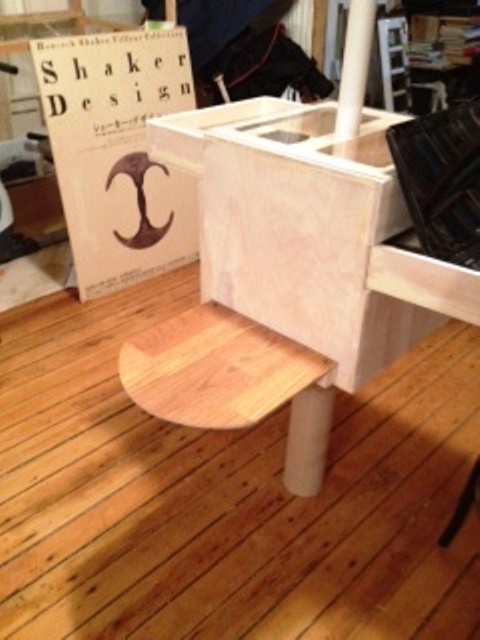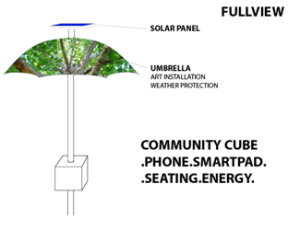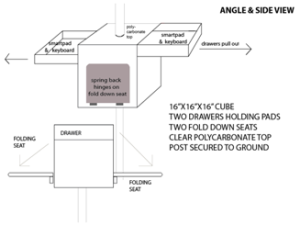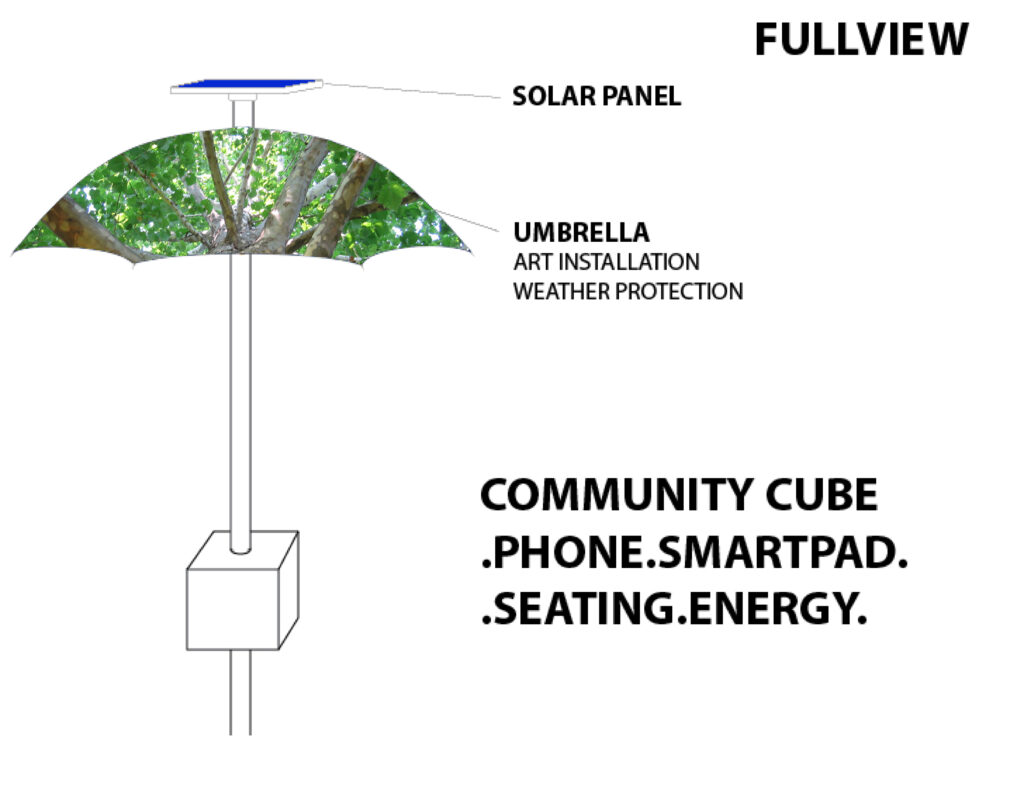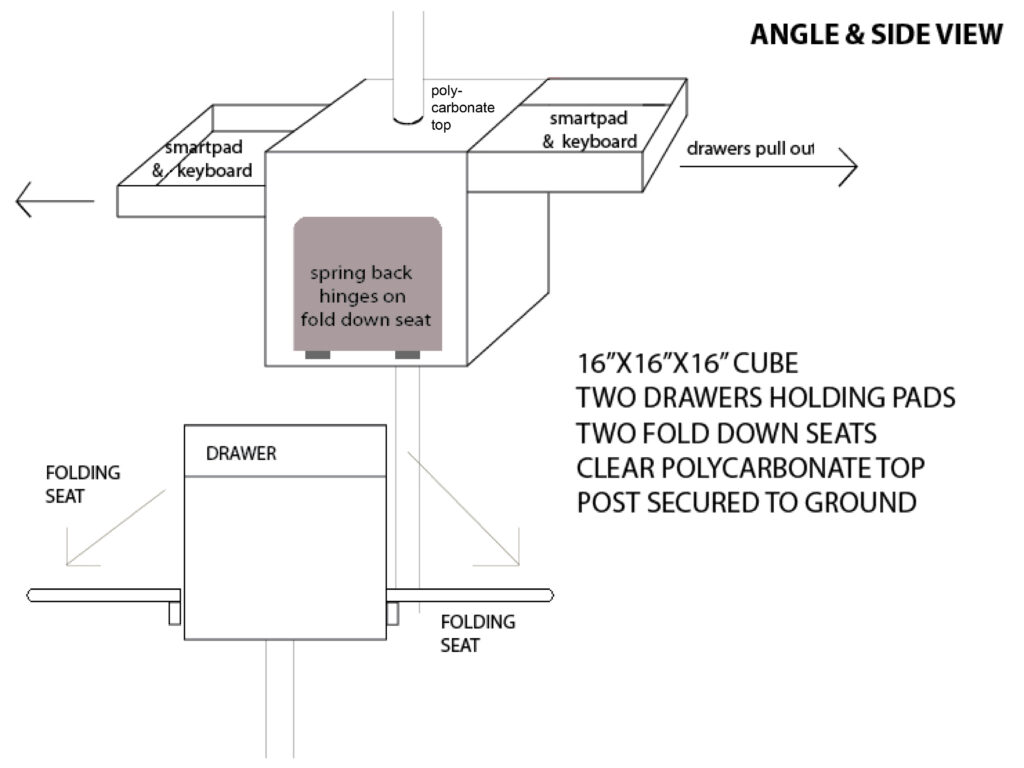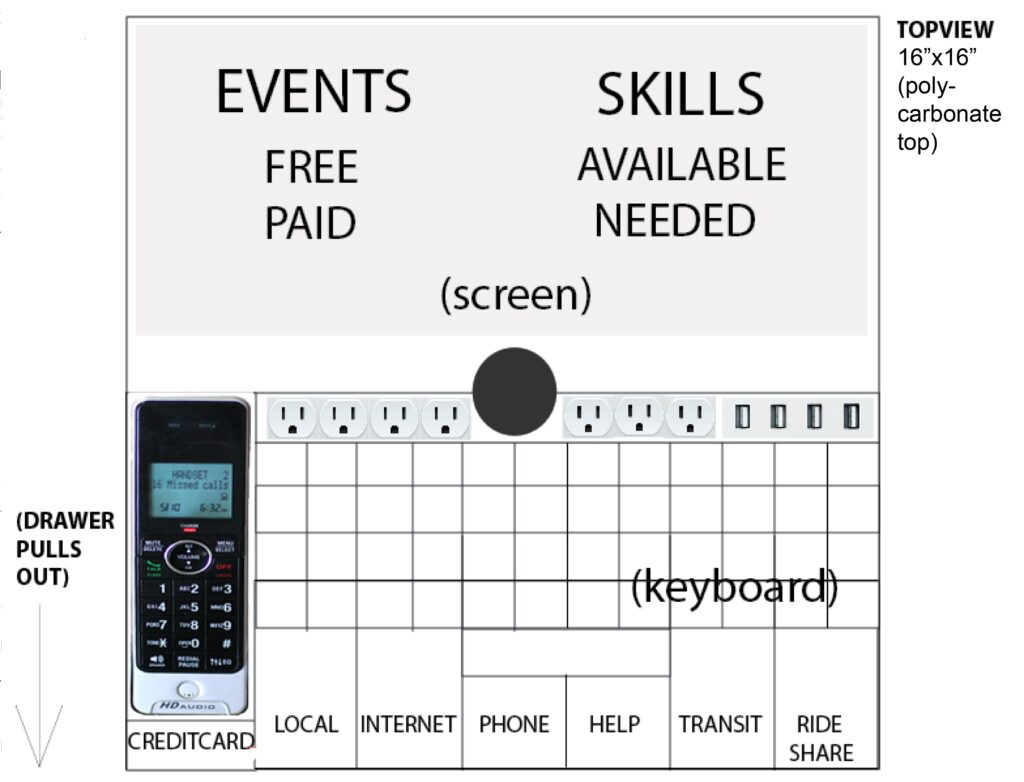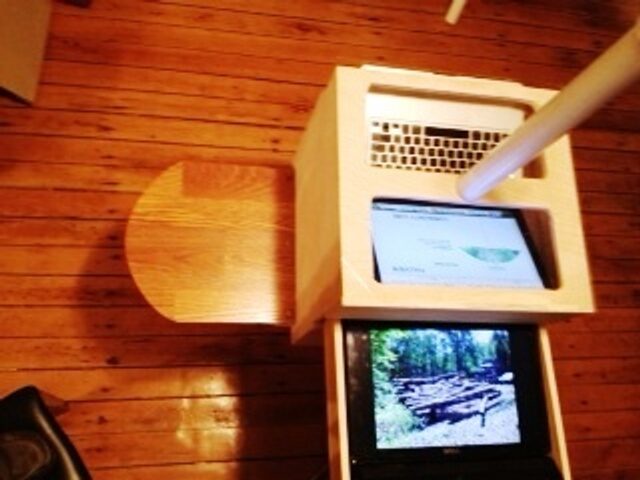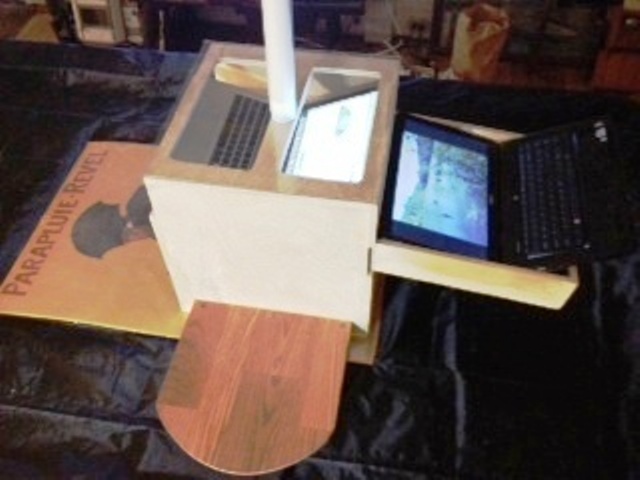Our submission to the 2013 New York City “Payphone” Design Contest
Unique all-purpose shelters can be made by local artists and craftspeople, to provide protection against bad weather at bus stops and elsewhere, to give neighborhoods natural gathering spots and bulletin boards, ways to encourage help availability, organize healthy exercise, enable resource-sharing, rides, etc.
SharingUmbrellas.org VEHICLES NEED STATIONS AND PEOPLE NEED SHARED SPACES
-
A campaign, over two years, from this Summer until late 2015, to encourage individuals and small groups to work on designing and building the next generations of human-scale urban transport vehicles and neighborhood-originated and operated, Transportation/Information/
Communications Stations. -
Although we are celebrating the 75th and 50th Anniversaries of the 1939 and 1964 World’s Fairs, instead of occurring only in NYC, this effort will take place at the same time in myriad locations. Wherever there is the interest, the tools and skills needed and a place to work, a group may form and identify itself.
-
Current wheelchairs and bikes do not provide weather protection, places for passengers or gear, the whole array of creature comforts, and other features that would permit them to be used by everyone at all times and ultimately replace, multi-ton, industrial-scale, urban-unfriendly vehicles.
-
Unique all-purpose shelters can be made by local artists and craftspeople, to provide protection against bad weather at bus stops and elsewhere, to give neighborhoods natural gathering spots and bulletin boards, ways to encourage help availability, organize healthy exercise, enable resource-sharing, rides, etc.
-
Local businesses, environmental, arts and education organizations, former world’s Fair exhibitors, etc. will be asked to offer support to local groups working on these projects, to give them seed money, or in-kind contributions of materials and services, to publicize and help transport their final products to NYC
-
We will expedite hospitality for participants, to find Queens residents willing to open up their homes to makers from their original home cities. This place, with the most diverse population on earth, is ideal to celebrate the universality of ingenuity and curiosity and our problem-solving abilities.
The 11,000 locations of current payphones were chosen primarily due to their potential to market their advertising panels. There are 25,000 more locations no longer active largely due to their relative lack of marketability, though they are already wired and potentially suitable. Meanwhile, since the City’s new criteria focus on their value to our communities, to serve in a variety of important roles, it is clear that they should now be dispersed throughout the city, in every neighborhood, rather than concentrated only at highly commercialized sites. Clearly, there could be many more, placed carefully, to provide a comprehensive system throughout the City.
The variations in terrain, pressure from congestion, and visual character of these diverse places suggests also that the amount of space taken up by these objects, and their relationships to the spaces around them must vary greatly, in order to best serve our neighborhoods. While the core equipment, like current phones, must conform to the existing communications and information technology requirements, the ability to develop these new facilities in such a way as to maximize their benefit to their surroundings and in harmony with them, is not only possible but vitally important as well.
One of the best networks of potential locations for phones is the 9,500 existing bus stops not currently served by shelters. Buses go where the people are and currently these stops are provided with nothing more than a pole and sign and map of the route. While many may be in sparsely-settled, relatively-unsuitable areas, the majority are along streets with substantial populations. There are currently no plans to provide shelters there since the existing franchise is limited to 3,200 fixtures. Since cellphone and solar technology have enabled the construction of a fully-functional facility without the huge expense of trenching for power and connectivity, it is no longer necessary to generate the amount of income from billboards that initially were required to justify this work.
Connectivity:
These recent technological advances, along with an infinite number of apps and other internet options, have created the opportunity to offer economical and convenient connectivity everywhere. We are now free to explore the potential to redefine our public spaces in a variety of very meaningful ways. Every plan you are being offered can take advantage of these advances by partnering with the relevant suppliers, who are happy to make their products and services available to anyone who can make use of them. The utilization of this equipment to provide local Wi-Fi, as well as everything currently online is neither expensive nor technically challenging. The ongoing success of City 24/7 here in the form of an easy-to-operate touch-screen is strong evidence that this system is already within easy reach.
Creativity:
While the current payphone design allows for some variations, we are suggesting that, to the degree possible, every one of these installations, aside from their “Equipment Modules” be as unique as possible, rather than highly uniform. This can be accomplished through the design and construction of “Umbrellas” over each location, so calls can be made and work done without having to protect oneself against falling rain or snow. Resting on strong frameworks, which also support the solar cells powering the facility, these creative constructions can be chosen through a myriad of local design contests with strong preference given to those living within the proximity of the object. Colorful, fun, or dignified, made of metal or cloth, these artistic statements can also be a unique reflection of the communities which surround them.
This system can transform our City into the friendliest environment for creative activity in the world by developing the means to use these payphone locations as both sources of art as well as being the art themselves. By enabling the screens to constantly provide examples of local creative output, the emphasis can be directed towards the work product of many of the residents of all of our neighborhoods, visual art, design, musical and written expression, etc.
To accomplish this you must design a program that will attract the positive attention of the immense creative community which makes New York its home and motivate them to relate constructively to this new phenomenon. While some make their livelihood this way, this is also an aspect of everybody’s day-to-day activity. (Improvising ways to contend with the challenges of daily life is one way that we learn to appreciate the value of creative thinking). Who knows that their next-door neighbor is a painter or graphic artist, composer, or performer? These neighborhood bulletin boards can serve to introduce us to one another and to help us appreciate the richness of talent of those living here.
Visual Design:
Billboards are intrusive and largely unpopular. Many feel that they cheapen the visual landscape. It is also possible that they lower the real estate values of adjoining properties as well. Since many people’s living spaces, homes or apartments, constitute their most important reservoirs of value, this matters considerably. If these objects were artworks, unique and well made, instead of brash advertisements, how would that affect these values? Might it enhance them rather than diminish them? Since the functional aspect of these devices has been shrunk down to a small, thin panel, why not use the rest of the space in the most aesthetic and wonderful way?
We think that this can be as important a feature of this program as the technology being made available. If screens are pointing upwards instead of outwards, as a rule, their negative impact of them is eliminated entirely.
Functionality:
Survival is the paramount concern of a substantial portion of our population. Finding satisfying and rewarding work is an urgent need. Using these facilities to provide a work exchange element, which can also be replicated online, through the posting of local needed help is not only possible but is already taking place. Running errands, walking dogs, painting apartments, many tasks are always there to be accomplished and there are already a host of websites devoted to this. Presenting their availability through the posting of qualifications and references improves the likelihood of satisfying these needs in the most immediate and dependable way.
Re-charging stations for computers and cellphones are an obvious use, but it is also possible to vend or rent these items as well. This could not be done everywhere due to security concerns, but modern vending machines dispense everything today including such items. It has become commonplace to do this in hotels and airports etc. and “Automats” have been around for more than a century. Up-to-date urban centers must develop the capacity to satisfy these needs today.
Payphones can also be combined with other kinds of needed street facilities, whether they be bus stops or new types of newsstands. At selected locations, it may be worthwhile to fully enclose these information/communication/transportation structures and make them suitable for temporary habitation by local residents. Access at different times can be provided both to those volunteering to manage them on behalf of their communities needs as well as to those making a living. Income from this activity can be used to justify the expense of construction and maintenance. Just as we once had 1500 sidewalk newsstands, this city and its historic density and diversity make even such ambitious plans practical in many places.
Community Impact:
This is the essence of this proposal since the implementation of this program could radically upgrade the availability of both helpful information as well as actual physical help. The interaction among neighbors today, almost everywhere within the city is minimal. We usually do not even know our neighbors’ names or what they do. This has its benefits in terms of privacy and freedom from unwanted and un-needed intrusions into our individual lives but it is a condition that many would choose to change. Instead of waiting for a catastrophe to remind us how much we have in common and can benefit from each other, it is time to establish mechanisms to expedite these realizations. How many people would join walking, Tai Chi, or other exercise groups, to help to improve their own or others’ health while meeting and getting to know one another?
There are already numerous blogs designed to help neighbors relate to one another much more closely. Many of these have been put together by relatively young people and a program to encourage their formation will expand this network considerably. Should these communicators be given a physical location close to where they live to “broadcast” this information locally and include the capacity to enter information as well as obtain it, this will make the formation of this mini-blogs even more attractive. Since all of these efforts are voluntary, they will cost nothing to construct and operate and may even help to generate income for the program through advertising and other commercial elements. The display of locally-produced artwork and other products could lead to some commerce as well as greater awareness.
The object here is to aim high, to not dismiss any idea or approach that could benefit this society so greatly. It should take years to roll out ideas and test them properly. Giving the public a chance to craft a stake in its own public spaces is the key. “Re-owning the phone”, as Mayor Bloomberg referred to this program, can well be the first step in “Re-owning the neighborhood”.
From the drawing board:
To the Prototype:
Sharing Umbrellas
We are inviting designs to be submitted of new human-powered and electric-assisted human-scale vehicles including so-called “wheelchairs”. We are most interested in concepts that incorporate weather protection and passenger capacity but there are no limits on type or style, speed, or cost. Cargo bikes, recumbents, folders, wheelchairs, public transit i.e. shared, or convertible from commuter to commercial, Kinetic Sculpture, and Velomobiles, all are welcome. Pictures of existing machines will be featured and drawings and models and descriptions are fine too.
The second element of this endeavor has to do with the current conversations taking place relative to the definition of public space, the role of neighborhoods and their residents in that process, and advertising in this equation. At least minimal cover, an Umbrella-like object should be available to the public at practically every bus stop instead of only 25% of them. The proliferation of unique, attractive, and community-welcomed designs for these facilities, especially if produced and fabricated by local residents, could, most importantly, do much to help encourage a new level of healthy interactions among those living and working here, even just those passing through.
Images and text from individuals and groups are already being posted on SharingUmbrellas.org and will be updated regularly. Each person will be included in the slideshow which plays on the home page and provides a link to their own page. Some will also be printed, in a full-color tabloid, issued monthly to begin, in New York City and distributed to bike shops, bookstores, newsstands and cafes, and at gatherings of those most interested in these developments. Other local groups working on these issues who want to print their own local editions will be encouraged to do this.
One venue for showing off these devices will be New York City’s largest car-free space, Flushing Meadows/Corona Park in Queens. To help celebrate the 50th and 75th Anniversaries of the 1939 and 1964 World’s Fairs, in 2014 and 2015, this great public park will serve as a natural backdrop for the public unveiling of our human-scale transportation future. Craft, technology, and the creative imagination; sharing its most intriguing fruits; learning and being inspired; all the wonders of an event that consciously endeavors to be as inclusive geographically, culturally, and socially as possible, can help expedite the rapid evolution of this key feature in our environment, how we get around.
How can the “Community Cube” be used to improve The quality of life of those who are living here?
Health
Exercise
Walking
Around the block, as a starting point and to keep track
To nearby destinations for pleasure or utility
Historical/ Architectural/ Natural etc. tours given by local residents
Can include different speeds from relaxed to brisk up to running
Mild competition increases motivation but no racing
Also benefits safety
In case of an incident can seek or provide help
In numbers, there is little chance of trouble
More eyes on streets in general benefits all
Stretching
In the proximity of the location, without interfering with pedestrians
Somewhat protected in bad weather as long as there is an “Umbrella”
Can include guidance from a knowledgeable neighbor or online instructor
Tai Chi
Informal or guided includes other dance or movement methodologies
Biking
Shared vehicles and modest costs
Different style vehicles
Different age kids
Cargo and commercial
Cruisers
Electric-Assisted
Trikes
Special Need varieties
Multi-person
Measured distance trips to events, attractions, tours of every kind, etc.
For shopping, picking up kids, giving rides to friends, etc.
Commuting (can include machines used by others during the day)
Re-charge and lock-up aids and folders to expedite the availability
Scheduled discussions
Anyone can create a subject category and schedule a one-hour local conversation
Information is also available later online if archived
Can be “broadcast” to non-attendees via Skype if preferred by participants
Can be a private conversation among a small number of people
Cube doubles as a “Soapbox”
Charges for some services, others are free
Monitors and moderators-Blogs for Blocks
No age limit, 10 to 100, and cannot be small-minded or autocratic
Those already operating can be invited to be part of this network
Generating consensus is the goal, getting as close as possible is often enough
Local residents choose individual or multi-person units to “operate” Cube
Ground rules should be permissive but not abusive
Association with adjacent businesses, (at locations where they exist) provides:
Access to services
Power
Sanitation facilities
Help if needed
Storage
Reciprocal Aspect
Advertising
Goodwill
Backup personnel
Possible Investment
Professionals
Insurance
Finance
Accounting
Law
Health
Survival Issues
Job Exchange
Help needed and available
Tutoring, educating, upgrading skills
Physical, moving of something
Coping issues
Painting
Repairs
Horticulture
Cleaning
Childcare
Transport
Health care
Research/writing
Shopping
Delivery
Tasks needing to be done
For Pay
Without monetary compensation
In exchange for…………system’s own currency
Celebrations
Birthdays
Pictures shown
Births
Presents Offered
Graduations
Listings
Anniversaries
Of local events as well as relationships
Achievements
Share the warmth, share the glory
Passing
Sad, but worth noting
Life Histories
Includes contact information
Virtual resumes
Willingness to volunteers
Needs
Work
Personal
Help
Done by you, not about you
Neighborhood History
Previous generations
Notorious
Early
Continuous
Grab it before it is done
Commercial
Plantings
Existing
Possible
Cooperatively maintained
Native
Micro
Edibles
Soil conditions analysis performed
The spot itself can provide a location
The sidewalk around block=10 gardens
Artwork
Locally produced only
Constantly displayed
Rotating exhibits
Locked showcases and Virtual displays
Music and poetry-quietly and on demand
“Umbrella” itself is art
Enclosing the space
Historical
Newsstands
Phone Booths etc.
Mixed Use by both volunteers and private interests
An adequate room must be provided for public uses
Permits expanded vending opportunities
The mechanism for registering sentiment on various issues
Questions posed
Creative suggestions invited
Results posted publicly
Setting up feedback loops
